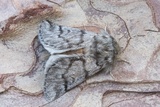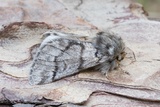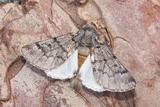Thaumetopoea pityocampa ([Denis & Schiffermüller], 1775) Species
Last modified: Sept. 24, 2025, 2:48 p.m.
New to Belgium in 2021 in LX.
Details
- Classification
- Family: Notodontidae > Subfamily: Thaumetopoeinae > Genus: Thaumetopoea > Species: Thaumetopoea pityocampa
- Vernacular names
- Dennenprocessierups (NL), Pine processionary (EN), La Processionnaire du Pin (FR), Pinien-Prozessionsspinner (DE)
- Status
-
Native
Distribution
Imago
Wingspan 34–43 mm. The moths are generally larger than their cousin Thaumetopoea processionea. The crossbands on the forewing are more sharply drawn and serrated and the spot is larger. The hindwings are also more whiter.
Egg
The cylindrical egg masses range in length from 4 to 5 cm. They are covered with the scales of the female anal tuft, which mimics the pine shoots. Most eggs masses are laid on the peripheral shoots of the crown of the food plant.
Caterpillar
It gets its name from the caterpillars distinctive habit of moving about in nose-to-tail processions, this occur in late winter and early spring
Like its cousin, Thaumetopoea processionea, the caterpillars of this species also have thousands of tiny hairs which contain an urticating, or irritating, protein called thaumetopoein, giving rise to its scientific name. If these hairs come into contact with people and animals, they can cause painful skin, eye and throat irritations and rashes and, in some rare cases, allergic reactions.
They even have a few more hairs than the oak processionary caterpillar, up to a million in the fifth larval stage.
The white, silken nests , which the caterpillars build among the foliage early in the year, are the most obvious sign of the pest’s presence, together with some defoliage of the trees later in the year.
Bionomics
The eggs hatch in September and continue through the winter as a caterpillar while sitting in their nests. They form their nests immediately after the eggs hatch. Eventually, white nests develop in trees and also in young plants and seedlings. The caterpillars feed on the needles of pine trees and some other conifer tree species, and in large numbers they can severely defoliate trees.
In spring, the larvae leave the host plants and start walking in a procession in search of a place to burrow into the ground to pupate.
The adults come to light.
Flight periods
Adults are on the wing mainly during July and August.
Observed on
- Host plant (species):
- Larix decidua
- Host plant (genera):
- Pinus
The larva lives mainly on different species of Pinus, but also on Cedrus atlantica and Larix decidua. Also Crataegus and Quercus ilex are mentioned in the literature.




